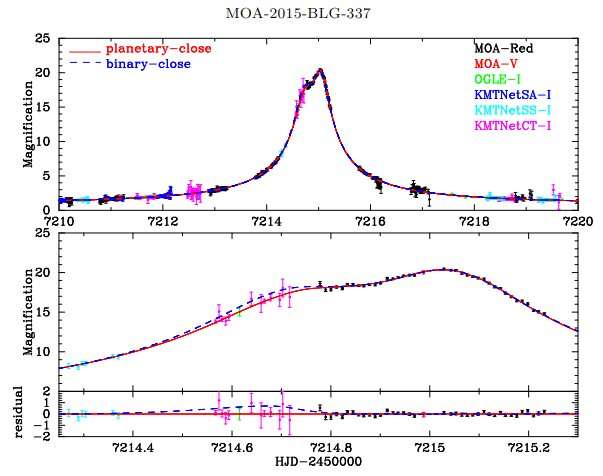April 9, 2018 report
Planet orbiting a brown dwarf or a brown dwarf binary? Astronomers use cosmic lens to find new substellar system

Using gravitational microlensing technique, an international group of astronomers has found a new substellar system whose composition remains a puzzle. The newly detected system, designated MOA-2015-BLG-337L, may consists of a planet orbiting a low-mass brown dwarf or may be composed of two brown dwarfs. The finding is detailed April 3 in a paper published on arXiv.org.
Based on the gravitational lens effect, the microlensing method is mainly used to detect planetary and stellar-mass objects regardless of the light they emit. This technique is sensitive to low-mass planets orbiting relatively faint host stars like M dwarfs or brown dwarfs. Therefore, microlensing can play an important role for understanding the formation of very low mass stars and brown dwarfs by detecting companions of low-mass hosts.
A team of astronomers, including the Microlensing Observations in Astrophysics (MOA), the Optical Gravitational Lensing Experiment (OGLE) and the Korea Microlensing Telescope Network (KMTNet) Collaboration, has employed this method to detect a new system composed of at least one brown dwarf. The researchers have analyzed the microlensing event MOA-2015-BLG-337, first observed by MOA using the 1.8 m MOA-II telescope at Mount John University Observatory (MJUO) in New Zealand. The analysis resulted in a discovery of a new system designated MOA-2015-BLG-337L.
"In this paper, we report the discovery and present the analysis of the short-timescale binary microlensing event, MOA-2015-BLG-337. We find two competing models that explain the observed data. One comprises a planetary mass-ratio lens system and the other, a binary mass ratio lens system," the researchers wrote in the paper.
The first scenario explaining the observational data proposed by the team suggests that MOA-2015-BLG-337L is composed of a brown dwarf with a mass between 6.3 and 29.3 Jupiter masses orbited by a planet dozens of times more massive than the Earth (between 21.6 and 100.7 Earth masses). According to the estimates, the planet should be circling its host at a distance of approximately 0.25 AU.
The other hypothesis proposed by the researchers implies that the newly found system is a brown dwarf binary in which one component has a mass within the range of about 64 to 78 Jupiter mass and its companion has a mass between 11.4 and 18.3 Jupiter masses. The astronomers noted that the two objects are most likely separated from each other by 0.19 as well as 3.3 AU.
"We find two competing models that explain the observed data. One comprises a planetary mass-ratio lens system and the other, a binary mass ratio lens system," the paper reads.
The researchers concluded that analysing such events as MOA-2015-BLG-337 is important for the study of planetary formation in very low-mass objects. However, they added that much more research is required to improve existing knowledge in this field. For instance, the astronomers hope that future microlensing surveys, like the PRime-focus Infrared Microlensing Experiment (PRIME), will reveal the frequency of exoplanets around low-mass brown dwarfs and even the frequency of planetary mass objects orbited by exo-moons.
More information: MOA-2015-BLG-337: A Planetary System with a Low-mass Brown Dwarf/Planetary Boundary Host, or a Brown Dwarf Binary, arXiv:1804.00830 [astro-ph.EP] arxiv.org/abs/1804.00830
Abstract
We report the discovery and the analysis of the short timescale binary-lens microlensing event, MOA-2015-BLG-337. The lens system could be a planetary system with a very low mass host, around the brown dwarf/planetary mass boundary, or a brown dwarf binary. We found two competing models that explain the observed light curves with companion/host mass ratios of q~0.01 and ~0.17, respectively. From the measurement of finite source effects in the best-fit planetary model, we find a relatively small angular Einstein radius of theta_E ~ 0.03 mas which favors a low mass lens. We conduct a Bayesian analysis to obtain the probability distribution of the lens properties. The results for the planetary models strongly depend on the minimum mass, M_min, in the assumed mass function. In summary, there are two solutions of the lens system: (1) a brown dwarf/planetary mass boundary object orbited by a super-Neptune (the planetary model with M_min=0.001 M_sun) and (2) a brown dwarf binary (the binary model). If the planetary models is correct, this system can be one of a new class of planetary system, having a low host mass and also a planetary mass ratio (q <0.03) between the host and its companion. The discovery of the event is important for the study of planetary formation in very low mass objects. In addition, it is important to consider all viable solutions in these kinds of ambiguous events in order for the future comprehensive statistical analyses of planetary/binary microlensing events.
© 2018 Phys.org




















